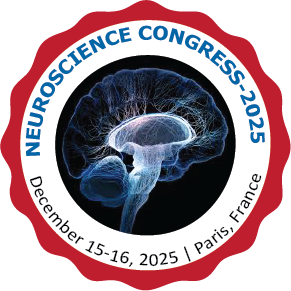Sessions & Tracks
Session:1 Psychological and Psychiatric
The term psychological pertains to the mind, emotions and behavior and is part of the broader field of psychology. Psychology is the scientific study of how humans (and sometimes animals) think, feel and behave. It seeks to understand why people behave the way they do, their mental processes, and how various factors influence their emotional well-being and decision-making.
Key Aspects of Psychology:
-
Psychology studies mental processes (e.g., thoughts, feelings, memories) and observable behaviors.
-
It involves understanding how biological, social and environmental factors influence human behavior.
Branches of Psychology:
Psychology is a diverse field with several branches, such as:
-
Clinical Psychology: Focuses on diagnosing and treating mental health issues like anxiety, depression, and trauma.
-
Counseling Psychology: Helps individuals manage stress, improve relationships, and navigate life challenges.
-
Cognitive Psychology: Explores mental processes like memory, decision-making, and learning.
-
Developmental Psychology: Examines human growth and changes across the lifespan (e.g., childhood to old age).
Session:2 Psychology of Brain Aging: Understanding Emotional Well-Being
As the brain ages, significant changes occur that can influence emotional well-being, cognitive functioning and overall mental health. The psychology of brain aging focuses on understanding how these changes affect emotions and behaviors, as well as identifying ways to maintain or improve emotional well-being throughout the lifespan.
Aging and the Brain: The aging brain undergoes both structural and functional changes
Structural Changes:
-
Shrinkage in certain brain regions, such as the prefrontal cortex (responsible for decision-making and emotional regulation) and the hippocampus (critical for memory).
-
Decline in gray matter and reduced connectivity in white matter, which can affect information processing.
Neurochemical Changes:
-
Decrease in neurotransmitters like serotonin, dopamine, and norepinephrine, which play a role in mood regulation.
-
Alterations in brain plasticity, which may reduce the ability to adapt to new situations or recover from stress.
Cognitive Changes:Slower processing speeds, reduced working memory, and occasional forgetfulness, though these are considered normal aspects of aging.
Emotional Changes in Aging:
Despite cognitive decline, emotional well-being often remains stable or even improves with age due to several psychological and neurological factors:
-
Socioemotional Selectivity Theory (SST):
Older adults tend to focus more on emotionally meaningful goals and relationships rather than pursuing broad or long-term goals. This shift in priorities can lead to greater emotional satisfaction.
-
Positivity Bias:
Studies suggest that older adults often pay more attention to positive stimuli and memories, which enhances emotional resilience.
Session:3 Psychopathology
Psychopathology refers to the scientific study of mental disorders, including their symptoms, causes, development and treatment. It examines behaviors, emotions and thought patterns that are considered abnormal or maladaptive and aims to understand the mechanisms underlying mental health conditions.
Normal vs Abnormal Behavior:
Psychopathology distinguishes between normal and abnormal behavior:
-
Normal Behavior: Conforms to societal norms and expectations, adapts to situations, and generally promotes well-being.
-
Abnormal Behavior: Deviates from societal norms, causes distress, impairs functioning, or poses a risk to oneself or others.
However, the distinction is often influenced by cultural, social, and situational factors, making it complex and subjective.
Fields Related to Psychopathology:
Psychopathology is a multidisciplinary field, intersecting with:
Clinical Psychology: Focuses on diagnosing and treating mental health conditions.
Psychiatry: A medical field that addresses mental disorders through medication and therapy.
Neuropsychology: Studies how brain abnormalities influence behavior and mental processes
Developmental Psychology: Examines how mental disorders emerge and change over a person’s life span.
Session:4 Psychiatric Immunology and Physiological Psychology
Psychiatric Immunology and Physiological Psychology are two fascinating fields that bridge biology, psychology, and mental health. They explore how physiological processes and the immune system affect mental health and behavior, contributing to our understanding of psychiatric disorders.
Psychiatric Immunology:
Psychiatric Immunology focuses on the relationship between the immune system and psychiatric disorders. This field studies how immune responses influence brain function, emotions and behavior.
Neuroinflammation:
-
Chronic inflammation in the brain has been linked to psychiatric conditions such as depression, anxiety, and schizophrenia.
-
Microglia, the brain's immune cells, play a key role in neuroinflammation, either protecting or harming the brain depending on their activity.
Cytokines and Mental Health:
-
Cytokines are proteins released by immune cells that regulate inflammation.
-
Elevated levels of pro-inflammatory cytokines (e.g., IL-6, TNF-α) have been associated with major depressive disorder (MDD), bipolar disorder, and PTSD.
-
Anti-inflammatory treatments (like certain antidepressants or immunotherapies) are being investigated for psychiatric conditions.
Stress and Immune Function:
-
Psychological stress activates the hypothalamic-pituitary-adrenal (HPA) axis, increasing cortisol levels.
-
Prolonged stress can dysregulate immune function, leading to increased inflammation and susceptibility to mental health issues.
Autoimmune Disorders and Psychiatric Symptoms:
-
Autoimmune diseases (e.g., lupus, multiple sclerosis) can cause psychiatric symptoms like depression, psychosis, or cognitive dysfunction.
-
Emerging research shows that autoantibodies (antibodies targeting the body's own tissues) can directly affect brain function.
Gut-Brain-Immune Axis:
-
The gut microbiome influences both immune function and brain health.
-
Dysbiosis (an imbalance in gut bacteria) is linked to mood disorders and neurodevelopmental disorders like autism.
Session:5 Cognitive and Behavioural Science
Cognitive and behavioural science is a multidisciplinary field that examines how mental processes (cognition) and actions (behavior) are interlinked. It seeks to understand how humans and animals perceive, think, learn, feel and act, using insights from psychology, neuroscience, linguistics and computer science.
Key Areas of Study in Cognitive Science:
Perception:
-
How we interpret sensory information from the environment (e.g., visual, auditory, tactile input).
-
Studies how the brain transforms external stimuli into meaningful experiences.
Attention:
-
How we selectively focus on certain information while ignoring distractions.
-
Research explores mechanisms behind sustained, selective, and divided attention
Memory:
-
Examines how information is encoded, stored, and retrieved.
-
Includes short-term memory, long-term memory, and working memory systems.
Language Processing:
-
Studies how we produce, understand, and acquire language.
-
Focuses on syntax, semantics, and the neural underpinnings of language.
Session:6 AI and Machine Learning in Mental Health
The integration of Artificial Intelligence (AI) and Machine Learning (ML) in mental health care is revolutionizing how mental illnesses are diagnosed, monitored, and treated. These technologies leverage vast amounts of data to uncover patterns, predict outcomes, and deliver personalized interventions. Below is a comprehensive look at how AI and ML are reshaping the mental health landscape.
AI and ML algorithms can analyze various data sources to detect early signs of mental health conditions and predict their onset.
Behavioral Data Analysis:Smartphones and wearable devices track changes in sleep patterns, physical activity, and speech, which may indicate conditions like depression or bipolar disorder.
Risk Prediction Models:Predicting suicidal ideation, relapse in substance use, or the likelihood of developing anxiety disorders based on historical data and lifestyle patterns.
Session:7 Psychological Interventions
Psychological interventions are structured strategies designed to improve mental health, emotional well-being, and behavior. These interventions are based on evidence-based psychological principles and are typically used to treat mental health disorders, promote positive behaviors, or help individuals cope with challenges in life. Below is a comprehensive overview of psychological interventions, their types, and applications.
Goals of Psychological Interventions:
-
Alleviating Symptoms: Reducing emotional distress, such as depression, anxiety, or PTSD symptoms.
-
Enhancing Coping Skills: Teaching individuals strategies to deal with stress, trauma, or life transitions.
-
Behavioral Change: Encouraging healthier habits, such as quitting smoking or improving diet.
-
Improving Relationships: Addressing interpersonal conflicts and fostering effective communication.
-
Building Resilience: Strengthening emotional and psychological resources to handle future stressors.
Session:8 Clinical Psychology and Psychotherapy
Clinical psychology and psychotherapy are closely intertwined fields dedicated to understanding, diagnosing, and treating mental health conditions. Clinical psychology focuses on the scientific study of psychological disorders, while psychotherapy provides therapeutic interventions to help individuals overcome emotional and behavioral challenges.
Key Functions of Clinical Psychology:
Assessment and Diagnosis:
-
Using tools like interviews, psychometric tests, and behavioral observations to identify mental health conditions.
-
Examples: MMPI (Minnesota Multiphasic Personality Inventory), Beck Depression Inventory (BDI).
Treatment Planning:
-
Developing evidence-based strategies tailored to the individual’s needs.
-
Combining psychological theories with therapeutic practices for comprehensive care.
Research:
-
Investigating the causes, risk factors, and treatment outcomes of psychological disorders.
-
Examples: Studying genetic predispositions to anxiety or the efficacy of mindfulness-based therapies.
Prevention:
-
Designing interventions to reduce the risk of developing mental health conditions.
-
Community programs addressing stress management and resilience-building.
Session:9 Psychological Case Studies in Mental Health
Case studies are detailed examinations of an individual's psychological issues, symptoms and the therapeutic processes used to address them. These provide valuable insights into mental health conditions, allowing professionals to understand diverse presentations of disorders and test the effectiveness of treatment approaches. Below is an overview of the role of case studies in mental health, their structure, and examples from key psychological conditions.
Benefits of Case Studies:
In-Depth Understanding:
-
They provide a detailed analysis of an individual's experiences, symptoms and environmental factor
Testing New Interventions:
-
Case studies serve as testing grounds for novel therapeutic approaches.
Educational Tool:
-
Case studies are used in teaching to illustrate real-world applications of psychological theories.
Session: 10 Child and Adolescent Psychiatry
Child and adolescent psychiatry is a specialized branch of psychiatry that focuses on the diagnosis, treatment, and prevention of mental health disorders in children and adolescents. It involves understanding the complex interactions between biological, psychological, and social factors that influence the mental health and development of young people.
Importance of Child and Adolescent Psychiatry:
Critical Developmental Period:
-
Early Development: Childhood and adolescence are critical periods for emotional, cognitive, and social development. Mental health during these years can significantly influence long-term well-being.
-
Impact of Untreated Disorders: Left untreated, mental health conditions in young people can affect academic achievement, social relationships, and overall life trajectory.
Unique Challenges:
-
Varied Presentations: Symptoms of mental health disorders in children and adolescents may look different than in adults. For example, anxiety might manifest as irritability or physical complaints rather than verbal expressions of worry.
-
Family Dynamics: The involvement of family members and caregivers is central to treatment, as children's behaviors and symptoms often affect the family unit.
-
Stigma: Mental health issues in young people may be misunderstood or dismissed by adults or peers, making treatment more challenging.
Session: 11 Women's Mental Health
Women's mental health is a critical area of focus within the field of psychology and psychiatry, as women face unique social, biological, and psychological factors that influence their mental well-being. Mental health issues in women can be affected by hormonal fluctuations, societal roles, and life transitions, among other factors. Understanding these unique aspects is essential for providing effective care.
Biological Factors:
Hormonal Change:
-
Hormonal fluctuations throughout a woman's life, including menstruation, pregnancy, menopause, and perimenopause, can significantly impact mental health.
-
Conditions like Premenstrual Dysphoric Disorder (PMDD) and Postpartum Depression (PPD) are linked to hormonal changes.
Genetic Factors:Women are at higher risk for certain mood disorders, like depression and anxiety, due to genetic factors and hormonal variations.
Reproductive Health: Polycystic Ovary Syndrome (PCOS), endometriosis, and other reproductive disorders can have a mental health impact, leading to issues like chronic pain, infertility, and hormonal imbalance.
Session:12 Health, Stress and Coping
Stress is a natural response to life’s challenges, but when it becomes chronic, it can significantly affect both physical and mental health. Understanding the relationship between health, stress and coping mechanisms is crucial for promoting well-being and managing the negative impacts of stress.
Stress refers to the body's reaction to any demand or challenge. Stress can be caused by both external and internal factors and can be triggered by events like work deadlines, relationship issues, financial struggles, or health problems. Stress can manifest in a variety of ways, including physical, emotional, and behavioral symptoms.
Types of Stress:
Acute Stress:Short-term stress that occurs in response to a specific event. This could be an exam, a job interview, or a confrontation. It is temporary and often resolves once the situation passes.
Chronic Stress: Long-term stress that persists over an extended period. Chronic stress can result from ongoing issues such as difficult relationships, work pressure, or ongoing health problems. It can have serious consequences for physical and mental health.
Session: 13 Stroke, Trauma and Epilepsy
Stroke, trauma, and epilepsy are distinct neurological conditions, but they can be interconnected and often share similar symptoms or outcomes, such as cognitive impairments, physical disabilities and emotional challenges. Below is an overview of each of these conditions, including their causes, effects and treatment options.
Ischemic Stroke:
-
The most common type, occurring when a blood clot blocks or narrows an artery supplying blood to the brain. This blockage prevents oxygenated blood from reaching the brain cells, leading to tissue damage.
-
Causes: Atherosclerosis, blood clots, heart disease, high blood pressure.
Hemorrhagic Stroke:
-
Occurs when a blood vessel in the brain bursts, leading to bleeding (hemorrhage) in or around the brain. This can cause swelling and pressure on brain tissue, leading to damage.
-
Causes: High blood pressure, aneurysms, head trauma, blood-thinning medications.
Transient Ischemic Attack (TIA):
-
Often called a "mini-stroke," this is a temporary blockage of blood flow to the brain. TIAs are short-lasting, but they serve as a warning sign for a future stroke.
Symptoms of Stroke:
Symptoms of a stroke often appear suddenly and may include:
-
Sudden numbness or weakness in the face, arm, or leg, especially on one side of the body.
-
Confusion, difficulty speaking or understanding speech.
-
Vision problems in one or both eyes.
-
Difficulty walking, dizziness, loss of balance, or coordination.
-
Severe headache with no known cause (more common in hemorrhagic stroke).
Session:14 Sleep Disorder
Sleep is essential for overall health and well-being, yet millions of people worldwide experience various types of sleep disorders. These disorders can affect sleep quality, duration, and timing, leading to significant disruptions in daily life. Here's an overview of common sleep disorders, their causes, symptoms and treatments.
Insomnia:
Insomnia is the most common sleep disorder, characterized by difficulty falling asleep, staying asleep or waking up too early and not being able to go back to sleep.
Causes:
-
Stress or anxiety
-
Depression
-
Poor sleep habits
-
Medical conditions (e.g., chronic pain, asthma)
-
Medications (e.g., stimulants, antidepressants)
Symptoms:
-
Difficulty falling asleep or staying asleep
-
Waking up feeling unrefreshed
-
Daytime fatigue, irritability, or difficulty concentrating
Treatment:
-
Cognitive Behavioral Therapy for Insomnia (CBT-I): A type of therapy that helps individuals change thoughts and behaviors that affect sleep.
-
Medications: Sedatives or sleep aids may be prescribed temporarily, but they are not recommended for long-term use.
-
Sleep Hygiene: Maintaining regular sleep schedules, avoiding caffeine or alcohol before bed, and creating a calm sleep environment.
Session: 15 Positive Mental Health
Positive mental health refers to the state of well-being where an individual feels good, functions well in society, and can manage the challenges of life. It encompasses more than the absence of mental illness—it includes emotional, psychological, and social well-being. People with positive mental health are able to cope with life's stressors, work productively, build healthy relationships, and make meaningful contributions to their communities. Here's a deeper dive into the key aspects of positive mental health, its importance and strategies to nurture and maintain it.
Key Elements of Positive Mental Health:
Emotional Well-being:
-
Self-awareness: Understanding and managing your emotions effectively. This includes recognizing feelings like anger, sadness, or joy, and knowing how to handle them in constructive ways.
-
Self-acceptance: Being comfortable with who you are and having a positive self-image. It involves accepting your strengths and weaknesses without excessive criticism or self-doubt.
-
Resilience: The ability to bounce back from setbacks, adapt to change, and keep going in the face of adversity. Resilient individuals manage stress in healthy ways and maintain a positive outlook despite challenges.
Psychological Well-being:
-
Personal growth: Engaging in activities that promote self-improvement and development. This includes learning new skills, exploring new ideas, and striving to be the best version of yourself.
-
Purpose and meaning: Having a sense of purpose in life, such as pursuing goals or engaging in activities that align with your values. This provides a sense of direction and fulfillment.
-
Autonomy: The ability to make independent choices and control over one’s own life. People with positive mental health tend to feel empowered to make decisions and act in accordance with their beliefs.
Session: 16 Serious Emotional Disorder (SED)
A Serious Emotional Disorder (SED), also known as a Serious Emotional Disturbance (SED), is a term used to describe a range of mental health conditions that affect children and adolescents and are characterized by significant emotional or behavioral difficulties that impair their ability to function in social, academic, or familial settings. These disorders can severely impact a young person’s ability to form relationships, manage emotions, and cope with daily life. SED is typically diagnosed when these symptoms persist over time and significantly interfere with a child’s development.
Criteria for SED Diagnosis:
-
Long-term symptoms: The emotional or behavioral issues are persistent and have lasted for at least six months.
-
Severity: The condition severely disrupts daily functioning in areas like school, home, or social settings.
-
Non-normative behavior: The emotional responses or behaviors are much more intense or extreme than what is typical for the child's developmental stage.
Anxiety Disorders:Anxiety disorders involve excessive worry, fear, or nervousness that interfere with a child's ability to function. Common anxiety disorders in children and adolescents include:
-
Generalized Anxiety Disorder (GAD): Persistent worry or anxiety about a range of topics, often with no specific trigger.
-
Social Anxiety Disorder: Intense fear of social situations, leading to avoidance and isolation.
-
Separation Anxiety Disorder: Excessive fear or anxiety about being apart from a parent or caregiver.
Mood Disorders: Mood disorders affect the emotional state and can lead to feelings of extreme sadness, irritability, or emotional instability. Common mood disorders include:
-
Depression: Persistent feelings of sadness, hopelessness, and lack of interest in activities once enjoyed.
-
Bipolar Disorder: Characterized by extreme mood swings, including episodes of depression and mania or hypomania (elevated mood).
Attention-Deficit/Hyperactivity Disorder (ADHD):
ADHD is characterized by symptoms of inattention, hyperactivity, and impulsivity that interfere with a child's ability to function in academic, social, or home settings. Children with ADHD often struggle with:
-
Difficulty paying attention or staying on task.
-
Impulsive behaviors, such as interrupting others or making hasty decisions without thinking.
-
Hyperactivity, which may manifest as fidgeting, restlessness, or difficulty staying seated.
Session:17 Brain Tumour
A brain tumor is a growth or mass of abnormal cells in the brain. Tumors can either be primary (originating in the brain) or secondary (spreading from other parts of the body). Brain tumors can be benign (non-cancerous) or malignant (cancerous), and their severity depends on their type, size, and location within the brain. Brain tumors can impact brain function by pressing on areas responsible for various cognitive, motor and sensory processes.
Types of Brain Tumors:
Brain tumors are classified based on their location, type of cells involved, and whether they are benign or malignant.
Primary Brain Tumors: These tumors originate within the brain or spinal cord. Common types of primary brain tumors include:
Gliomas: The most common type of primary brain tumor, gliomas develop from glial cells, which provide support to nerve cells. Types of gliomas include:
-
Astrocytomas (including glioblastomas): These tumors develop from astrocytes (star-shaped cells that support nerve cells). Glioblastomas are among the most aggressive.
-
Oligodendrogliomas: Tumors that form in oligodendrocytes, the cells that make up the myelin sheath surrounding nerve cells.
-
Ependymomas: These tumors originate in ependymal cells lining the ventricles (fluid-filled spaces in the brain).
Meningiomas: These tumors arise from the meninges, the layers of tissue covering the brain and spinal cord. Meningiomas are usually benign but can cause significant symptoms depending on their size and location.
Pituitary Tumors: These tumors develop in the pituitary gland at the base of the brain, affecting hormone production and regulation. Most pituitary tumors are benign.
Medulloblastomas: These tumors are most common in children and develop in the cerebellum, the part of the brain that controls balance and coordination.
Schwannomas: These tumors grow from Schwann cells, which produce myelin. The most common type is the acoustic neuroma, affecting the nerve responsible for hearing and balance.
Neurocytomas: Tumors that develop from neurocytes, a type of neuron in the brain, typically in the areas around the ventricles.
Session: 18 Neuropsychiatry
Neuropsychiatry is a branch of medicine that deals with the interface between neurological and psychiatric conditions, where mental health issues and neurological disorders overlap. It focuses on the diagnosis and treatment of psychiatric symptoms arising from brain dysfunction, such as those caused by neurological diseases, brain injuries, or disorders that affect the central nervous system (CNS).
In neuropsychiatry, the goal is to understand and manage conditions that involve both the brain and the mind, recognizing that psychiatric symptoms may have a biological basis linked to brain abnormalities or disruptions.
Key Areas of Neuropsychiatry:
Neuropsychiatry covers a broad range of conditions that involve both the brain's physical structure and the mind’s psychological processes. These conditions can arise due to brain injury, neurodegenerative diseases, infections, genetic disorders and various other factors.
Neurological Disorders with Psychiatric Manifestations:
Some neurological diseases lead to psychiatric symptoms as a prominent feature. These conditions may include:
-
Dementia: Alzheimer's disease, vascular dementia, and frontotemporal dementia often involve cognitive decline, memory loss, and mood disturbances.
-
Parkinson's Disease: In addition to motor symptoms like tremors and rigidity, patients with Parkinson's disease can experience depression, anxiety, hallucinations, and cognitive impairment.
-
Multiple Sclerosis (MS): MS affects the brain and spinal cord, leading to symptoms like mood swings, depression, and cognitive dysfunction.
-
Epilepsy: Seizures and other neurological symptoms in epilepsy can be accompanied by psychiatric symptoms such as anxiety, depression, and cognitive difficulties.
-
Stroke: A stroke can lead to physical impairments and emotional or cognitive issues, including depression, personality changes, and difficulty with speech and memory.
-
Traumatic Brain Injury (TBI): Brain injuries can lead to mood disorders, personality changes, anxiety, and cognitive difficulties.
Session:19 Geriatric and Pediatric Psychiatry
Both geriatric psychiatry and pediatric psychiatry are subspecialties within the field of psychiatry that focus on mental health conditions across the lifespan, but each is specifically tailored to the unique needs of older adults and children, respectively. Both fields require specialized knowledge about the developmental, physical, psychological, and social factors that influence mental health at different life stages.
Geriatric Psychiatry: Geriatric psychiatry focuses on the mental health and emotional well-being of older adults, typically those aged 65 and older. This field addresses the specific psychological, cognitive, and emotional challenges faced by aging individuals, taking into account the impact of aging, chronic illnesses, and social changes.
Session: 20 Anxiety Disorders
Anxiety disorders are a group of mental health conditions characterized by excessive fear, worry, and apprehension. These disorders are among the most common mental health issues globally and can significantly affect daily functioning. People with anxiety disorders often experience intense and persistent anxiety or fear, which can be triggered by specific situations or occur without any clear trigger at all.
Anxiety is a normal emotional response to stress or uncertainty, but when it becomes excessive, chronic, and interferes with daily life, it may be considered a disorder.
Generalized Anxiety Disorder: GAD is characterized by excessive, uncontrollable worry about a variety of topics, such as work, health, social interactions, or everyday matters. This worry occurs most days and lasts for at least six months.
Symptoms:
-
Persistent, excessive worry
-
Restlessness, fatigue
-
Difficulty concentrating
-
Muscle tension, sleep disturbances
-
Irritability
Panic Disorder:
Panic disorder involves recurrent and unexpected panic attacks. These are intense surges of fear or discomfort that peak within minutes and are accompanied by physical symptoms.
Symptoms:
-
Rapid heart rate, sweating, chills
-
Trembling or shaking
-
Shortness of breath, chest pain
-
Nausea, dizziness
-
Fear of losing control or dying
Session: 21 Depression
Depression (also known as major depressive disorder or clinical depression) is a common but serious mood disorder that affects how a person feels, thinks, and handles daily activities. It goes beyond temporary feelings of sadness or grief and can cause significant emotional and physical distress. Depression is not just a passing mood or a weakness; it is a legitimate medical condition that can impact nearly every aspect of a person’s life.
Major Depressive Disorder (MDD):
This is the most common form of depression, characterized by persistent feelings of sadness, hopelessness, and loss of interest or pleasure in activities once enjoyed. Symptoms must last at least two weeks and affect daily functioning.
Symptoms:
-
Depressed mood most of the day
-
Loss of interest in activities (anhedonia)
-
Changes in appetite or weight
-
Sleep disturbances (insomnia or excessive sleep)
-
Fatigue or lack of energy
-
Feelings of worthlessness or guilt
-
Difficulty concentrating or making decisions
-
Suicidal thoughts or behavior
Session:22 Behavioural Health
Behavioral health refers to the connection between behaviors and the well-being of the mind and body. It encompasses the mental, emotional and social aspects of an individual's health and includes the ways in which our behaviors can impact our overall health and quality of life. Behavioral health focuses on understanding and improving how our thoughts, feelings, and actions influence our physical and mental well-being. It also addresses the treatment of mental health conditions, substance use disorders and other behavioral concerns that impact health.
Behavioral health is closely linked to both mental health and physical health. Our behaviors—such as how we cope with stress, manage relationships, or engage in daily activities—directly affect how we feel and function. Behavioral health is not limited to mental health problems but also includes how individuals manage their health behaviors (e.g., diet, exercise, substance use) and engage with their environment.
Mental and Emotional Health:
-
Mental health refers to emotional, psychological, and social well-being. Behavioral health plays a key role in maintaining mental well-being by addressing harmful behaviors that may arise due to stress, trauma, or mental health disorders.
-
Common behavioral health concerns related to mental health include anxiety, depression, anger management, and trauma responses.
Physical Health:
-
Certain behaviors, such as smoking, poor eating habits, lack of exercise, or excessive alcohol consumption, are linked to chronic conditions like heart disease, diabetes, and obesity.
-
Conversely, positive health behaviors (e.g., regular exercise, eating a balanced diet, and practicing stress management techniques) promote better physical health and well-being.
Session:23 Psychological Syndromes
Psychological syndromes refer to a group of symptoms that occur together and are characteristic of a particular mental health condition or disorder. These syndromes may manifest through emotional, cognitive, and behavioral symptoms, and their severity can vary widely from person to person. Psychological syndromes are often used to categorize mental health disorders, guiding diagnosis and treatment.
Anxiety Syndromes:
These syndromes involve excessive worry, fear, or nervousness that can be debilitating. Common anxiety syndromes include:
-
Generalized Anxiety Disorder (GAD): Characterized by persistent and excessive worry about everyday events or activities.
-
Symptoms: Restlessness, fatigue, difficulty concentrating, irritability, muscle tension, and sleep problems.
-
Panic Disorder: Involves recurrent and unexpected panic attacks, which are sudden surges of intense fear or discomfort.
-
Symptoms: Rapid heartbeat, sweating, chills, chest pain, shortness of breath, dizziness, and a feeling of choking.
-
Social Anxiety Disorder: A fear of social situations due to concerns about being embarrassed or judged.
-
Symptoms: Excessive fear of social interaction, avoidance of public situations, sweating, trembling, and difficulty speaking.
-
Phobias: Intense, irrational fears of specific objects, animals, or situations (e.g., heights, spiders, flying).
-
Symptoms: Overwhelming fear and avoidance behavior in response to the feared object or situation.
Session: 24 Understanding the Neurobiology of Autism Spectrum Disorders
Autism Spectrum Disorders (ASD) are a group of complex neurodevelopmental conditions characterized by challenges in social communication, restricted and repetitive behaviors, and sensory sensitivities. The neurobiology of ASD involves understanding the underlying brain structure, function, and the genetic, environmental, and biochemical factors that contribute to the development of these disorders. Research into the neurobiology of ASD is crucial for developing effective interventions and treatments.
Autism Spectrum Disorder: ASD encompasses a range of developmental disorders that vary widely in severity and manifestation. The core symptoms of ASD are related to two main areas:
-
Social Communication and Interaction: Difficulty with understanding and engaging in social interactions, challenges in non-verbal communication (e.g., eye contact, facial expressions), and trouble understanding social cues.
-
Restricted and Repetitive Behaviors: Repetitive movements (e.g., hand-flapping), insistence on sameness or routines, intense focus on specific interests, and sensory sensitivities (e.g., to light, sound, or touch).
Session: 25 Effective Strategies for Early Autism Diagnosis
Early diagnosis of Autism Spectrum Disorder (ASD) is crucial for providing timely interventions that can significantly improve developmental outcomes for children. The earlier a child is diagnosed, the sooner they can benefit from targeted therapies and support that address the core symptoms of autism, such as communication difficulties, social challenges, and repetitive behaviors. Early interventions have been shown to improve social, communication, and adaptive skills, as well as decrease behavioral problems.
Recognizing Early Signs of Autism: The early signs of autism may appear as early as 6 months of age, although the majority of diagnoses are made between 2 and 3 years of age. Recognizing these signs early can guide further assessment and intervention.
Social and Communication Signs:
-
Lack of eye contact: Infants and toddlers with ASD may avoid eye contact, which is crucial for social interaction.
-
Limited social smiling: A lack of reciprocal smiling or an absence of joyful reactions to familiar faces may be a sign.
-
Delayed speech or language development: Children with ASD may not use words or gestures to communicate as early as their peers.
-
Lack of pointing or gestures: By 12 months, most children use pointing, reaching, or waving, but children with ASD may not engage in these behaviors.
-
Difficulty with shared attention: A lack of interest in engaging in joint activities, such as looking at something another person is pointing to or sharing experiences, can be a red flag
Behavioral Signs:
-
Repetitive movements: Hand-flapping, rocking, or other repetitive movements may be observed.
-
Rigid routines and rituals: Children with ASD may become distressed if their routines or environment change.
-
Intense focus on specific objects or interests: A narrow, intense focus on certain topics or activities may be seen.
-
Sensory sensitivities: Overreaction or underreaction to sensory stimuli (e.g., lights, sounds, textures) can indicate sensory processing difficulties often associated with ASD.
Session: 26 Promoting Social Communication Skills in Individuals with Autism
Social communication is one of the core challenges for individuals with Autism Spectrum Disorder (ASD). Difficulties with understanding social cues, expressing oneself, and engaging in reciprocal interactions are common in individuals with ASD, affecting their relationships and integration into society. Early intervention and targeted strategies can help improve social communication skills, which are essential for success in school, work, and everyday life.
Understanding Social Communication Challenges in Autism:
Individuals with autism often face specific challenges in social communication:
-
Verbal and Non-verbal Communication: Some individuals may have limited verbal communication or struggle to use language appropriately. They may also have difficulty interpreting or using non-verbal cues such as facial expressions, body language, and eye contact.
-
Pragmatics (Social Use of Language): Pragmatics involves understanding how to use language appropriately in social situations, such as turn-taking in conversations, understanding humor, or knowing how to greet someone.
-
Social Reciprocity: Many individuals with ASD find it challenging to initiate or respond to social interactions in a typical back-and-forth manner. They may not understand the unspoken rules of social exchange.
-
Theory of Mind: Theory of mind refers to the ability to understand that others have thoughts, feelings, and perspectives different from one's own. This skill is often underdeveloped in individuals with ASD, making it harder for them to relate to others.
Session: 27 Supporting Transition to Adulthood for Autistic Individuals
The transition from adolescence to adulthood can be a challenging period for individuals with Autism Spectrum Disorder (ASD). Autistic individuals may face difficulties in adjusting to new expectations, increased independence, and navigating the social, academic, and professional demands of adulthood. However, with the right supports and interventions, these challenges can be addressed, and individuals with autism can lead fulfilling and successful adult lives.
Importance of Early and Ongoing Support:
The transition process should begin as early as possible, ideally in the teenage years, to allow ample time to develop the skills and support structures needed for adulthood. The support system should be ongoing and adaptable as the individual’s needs evolve.
Key Areas of Focus in the Transition to Adulthood:
Education and Vocational Training
Autistic individuals may experience difficulties in traditional educational settings due to challenges with communication, social interaction, and executive functioning. To ensure success in education and later in employment, the following strategies can help:
-
Individualized Education Plans (IEPs): A well-designed IEP that includes specific goals for academic achievement, social skills, and vocational preparation can significantly help autistic students. These plans should be reviewed and adjusted as the student nears adulthood.
-
Vocational Training: Offering practical, job-related training helps autistic individuals gain skills that are directly applicable in the workplace. This might include internships, apprenticeships, or vocational courses.
-
Postsecondary Education: Some autistic individuals may choose to attend college or vocational schools. Providing support such as tutoring, accommodations, or specialized programs for students with disabilities can be critical. Many colleges now have disability services that can assist with course planning, exam accommodations, and social integration.
-
Career Counseling: Early career guidance helps autistic individuals explore interests, strengths, and career options. Specialized counselors or mentors who understand the challenges faced by individuals with autism can provide valuable advice on how to navigate the workforce.
Session: 28 Inclusive Education: Empowering Autistic Students in Schools
Inclusive education refers to the practice of educating students with diverse learning needs, including students with Autism Spectrum Disorder (ASD), in regular classrooms alongside their peers. The goal is to provide equitable learning opportunities for all students, regardless of their abilities or disabilities. For autistic students, inclusive education can empower them by promoting social interaction, academic success, and emotional well-being. With the right support, autistic students can thrive in an inclusive environment.
Understanding the Importance of Inclusive Education for Autistic Students:
Inclusive education is important because it:
-
Promotes Social Integration: Autistic students have the opportunity to interact with their neurotypical peers, which helps build friendships and develop social skills.
-
Fosters Acceptance and Understanding: Inclusive classrooms help create a more accepting and supportive school culture. Neurotypical students learn to understand and appreciate diversity, which benefits everyone.
-
Improves Academic Outcomes: With appropriate supports, many autistic students can succeed academically in inclusive classrooms. This is particularly true when teaching methods are adapted to meet diverse learning styles.
-
Encourages Self-Esteem and Independence: Autistic students gain confidence when they are included in mainstream classrooms, given opportunities to participate fully in all aspects of school life.
Session: 29 The Role of Assistive Technology in Autism Interventions
Assistive technology (AT) refers to devices, tools, or software that help individuals with disabilities perform tasks that may otherwise be difficult or impossible. For individuals with Autism Spectrum Disorder (ASD), assistive technology can play a crucial role in supporting communication, learning, social interaction, and daily living skills. These technologies are designed to cater to the unique needs of autistic individuals, empowering them to overcome barriers and enhance their independence and quality of life.
Types of Assistive Technology for Autistic Individuals:
Assistive technology tools can be broadly categorized into the following areas:
Communication and Speech Support:
Communication challenges are one of the most common symptoms of autism. Many individuals with autism experience difficulty with verbal communication, leading to the use of augmentative and alternative communication (AAC) tools. These technologies can facilitate communication and improve interaction.
-
Speech-generating devices (SGDs): These devices allow individuals with limited verbal communication to communicate by selecting symbols, words, or pictures that are then spoken aloud by the device. Common SGDs include devices like Proloquo2Go, which is a tablet-based app that uses symbols and text-to-speech technology.
-
Picture Exchange Communication System (PECS): PECS uses pictures to help individuals with autism communicate needs, requests, and feelings. It is a widely used system that allows nonverbal individuals to communicate by exchanging pictures with their caregivers or peers.
-
Text-to-Speech and Speech-to-Text Software: For individuals with autism who have some verbal skills, speech-to-text software (such as Dragon NaturallySpeaking) can help them express themselves without needing to write by hand. Alternatively, text-to-speech software can read aloud written materials for individuals who struggle with reading comprehension or processing.
-
AAC Apps: Apps like LAMP Words for Life and GoTalk NOW are designed to assist with communication by providing customizable options for speech output through symbols and words, allowing users to communicate more easily with others.
Social Skills and Interaction:
Social communication can be a significant challenge for individuals with autism. Assistive technology can help improve social skills, understand emotions, and practice social interactions in a controlled and supportive environment.
-
Social Skills Apps: Apps such as Model Me Going Places and Social Skills for Autism provide virtual scenarios where individuals with autism can learn how to navigate social situations like greetings, turn-taking, and understanding body language.
-
Emotion Recognition Tools: Tools such as EmoReact or The Zones of Regulation apps help individuals identify and understand their emotions and the emotions of others. These tools use images, videos, or interactive exercises to teach emotional awareness and regulation skills.
-
Video Modeling Software: Video modeling is a technique used to teach social skills by showing a video demonstration of the desired behavior or interaction. Tools like iBehavioral and Model Me Kids create video scenarios that can help individuals with autism practice social skills in real-world settings.











